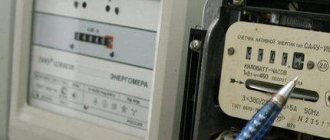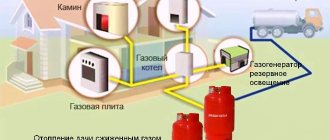Home / Heating /
For 9 years, at almost every project a builder always appears who, with a smart look, convinces the Customer to save on radiators and heat the house with heated floors. The customer has doubts and is right. At first glance, warm floors are more comfortable, but is it convenient for heating? Let's figure it out.
Good afternoon My name is Alexey Goltsov . I am a design engineer, author of articles. Heating is my main specialty. I carry out projects for country houses, shops and restaurants. 20 projects for country houses a year
I mainly design for Moscow and the region. I'm leaving for the site.
You can order a heating project from me on the “Services” .
Why did this question arise?
No matter how funny it may sound: global warming and the view of Western countries are to blame.
The design temperature for heating in Moscow is –25°C for 5 days. This temperature has not been seen for many years, and customers of private houses began to share the opinion that radiators do not work, and therefore are not needed.
Warm floors cost 3 times more than radiators. Therefore, this opinion was picked up by builders and for the last 5-7 years they have been confidently advocating to abandon radiators completely.
But there are 2 nuances in this issue that they do not take into account:
How many years are you building the house for?
My Customers often say that their neighbor’s underfloor heating works successfully. But neither the Customer nor the neighbor takes into account the period of time.
If we are talking about the short term of 3-5 years, then radiators are really not needed in this case. But the house is being built for a longer period.
In building codes, heating is considered efficient if it heats the house for 50 years. For Moscow, the minimum temperature for 30-50 years is -25°C. And even if there has not been such a temperature over the past 5 years, this does not mean that it will not happen in the coming decades.
Therefore, as a specialist, I design a combined system of radiators and heated floors. We are obliged to provide radiators as a reserve so that the house does not freeze in the cold winter.
We don't need to "heat the house"
Heating a house is an incorrect term.
The whole nuance is that we must maintain a different temperature in each room. We need to heat each room separately. In the boiler room, garage, storeroom, it is enough to maintain +15°C. In the bedroom +23°C, in the bathrooms and bathrooms +25°C.
Indeed, if we calculate the house as a single space, a warm floor for heating is quite enough, but in practice we only need to heat those rooms that border on external walls and windows.
For example, internal corridors, halls and storage rooms in a 250 m2 house are often about 50 m2, but they do not need to be heated at all.
Energy costs depending on the finish coating
When choosing a finishing material for laying on a warm electric floor, be sure to have a pictogram on the product that indicates the possibility of proximity to a heating device. More often, ceramic tiles, linoleum or parquet are laid on floor heating systems.
It is worth noting that the level of electricity consumption of 1 sq. m of a warm electric floor is also affected by the finishing, or rather its thermal conductivity. When choosing laminate or plank, your heating costs will increase, as they have a low degree of thermal conductivity.
But ceramics, linoleum or carpet are ideal and economically viable materials. The surface is heated quickly, and a minimal amount of resource is spent on this.
Is it possible to abandon radiators and heat the house only with heated floors?
From the legal side
Answer: No, you can't. If you contact a large construction company with such an idea, they will refuse you. There are 3 reasons for this:
1) The heating system is designed for the lowest temperature. For Moscow this is –25°C for 5 days. If the average temperature stays at -25°C for 5 days, no heated floors will cope. More details: SP60.13330.2016 clause 5.13.
Minimum winter temperatures in Moscow
2) The temperature of the floor surface should be no more than 26°C, and for children's institutions 23°C. This is too low a temperature to heat a room. Radiators heat up to 80°C. I will tell you further what overheating of the surface leads to. More details: SP60.13330.2016 clause 6.4.8
3) Cold convection currents always come from the window. Radiators cover 50% of the window width, which helps reduce the cold air flow from the window. More details: SP60.13330.2016 clause 6.4.4.
From a practical point of view
Answer: Yes, it is possible, but is it convenient? Unfortunately, neither customers nor builders see all the consequences. The customer relies on the experience of the builder. The builder relies on the experience of past projects. That’s why there are so many speculations and fantasies on the topic of heated floors.
I will share these consequences with you.
Computing technology
It should be noted right away that today there are services, such as online calculators and programs for calculating heated floors for individual conditions. Such programs are really very convenient and allow you to immediately determine the exact power of the film coating or heating cable. If for some reason you do not trust computer calculations, we recommend doing everything the old fashioned way - using simple formulas.
So, the formula for calculating electric heated floors is as follows:
P=Pm*Sroom,
Where:
- Pm – the power of the heating material, which you must choose yourself (more on this below), m2;
- Sroom – usable area of the room.
As you can see, the calculation formula is far from complicated, but it contains two unknowns that you must determine yourself. As for the usable area of the room, everything is simple. The heating mat, cable or film should be laid only in places where household appliances and furniture will not be placed. Firstly, this is already prohibited by manufacturers, because... foreign objects on the floor will interfere with heat transfer, causing the material to overheat. Secondly, what is the point of heating the surface where no one will walk? This is a waste of electricity. In the diagram you can see what the usable area of the room looks like for calculating an electric heated floor:
Useful heating area
Calculation of the usable area for laying an electric heated floor is carried out as follows: the width of the surface must be multiplied by the length.
As for the power of the heating material, you must choose it yourself, depending on the type of room. For each room, the power of infrared film or mat will be different, which is obvious - the balcony and corridor need heating more than the bedroom and children's room, which are additionally heated by water radiators.
We provide to your attention the most optimal values for calculating the power of an electric heated floor:
- kitchen: 110-130 W/m2;
- bathroom (WC): 120-150 W/m2;
- balcony: 180 W/m2;
- hallway: 110-120 W/m2;
- corridor: 110-120 W/m2;
- living room 110-130 W/m2;
- bedroom 110-130 W/m2.
Please note that the above values are suitable if the electric underfloor heating will be used as an additional heating system. If you decide to use this option as the main heating system, for each room you need to choose a heating material with a power of 140-180 W/m2
The usable area is known to you, the power parameters have also been selected. All that remains is to substitute the values into the formula and make a general calculation of the electric heated floor by power. To help you understand how to calculate this parameter, we will provide an example for one of the rooms below.
What problems do you have to face when heating underfloor heating?
The house will not warm up before your arrival
Warm floors without radiators respond very slowly to any commands and changes. His inertia is too high.
First, the system will receive a command from the boiler, then it will warm up 45 mm of concrete screed, 20 mm of floor covering, and only then it will begin to slowly release heat into the room. The floor temperature is 35°C. Therefore, to heat the house from the standby temperature of 15°C to a comfortable 23°C, the heated floor will need approximately 11 hours.
Heated floor heating rate graph
If you do not plan to live in the house 24/7, underfloor heating will be uneconomical. When you are not at home, you will have to maintain not 15°C, but 20°C, otherwise the house simply will not have time to warm up before your arrival. Radiators will heat a house from 15°C to 23°C in an average of 3 hours.
No reserve in case of extreme cold
In a combined system, radiators turn on at an outside temperature of -12°C and work together with the heated floor.
Warm floors are needed for comfort. That is why it is “warm” and not “hot”. Heating a house with underfloor heating will not work in extreme cold.
If you decide not to install radiators, you are deprived of a reserve that is guaranteed to heat the house in extreme cold. In this case, you will have to overheat the floors and run across the floor. Overheated surfaces will emit odor.
According to calculations: an overheated floor can heat a room down to -16°C. At lower temperatures, the floors will not cope and the room will be cold.
Floor covering - tiles or porcelain stoneware
Underfloor heating imposes its own limitations on the coating material. Even small carpets on the floor will have to be eliminated throughout the house, because they completely block the heat flow.
Heat transfer from the floor surface directly depends on the coating material. You won't be able to afford parquet, laminate, PVC or cork. all this is not suitable for underfloor heating systems. Laminate and parquet transfer heat 7 times worse than tiles.
Important nuance : the internal composition of the material is not so important as the surface itself! Matte and ribbed surfaces of the same porcelain stoneware transfer heat 30% worse than smooth ones.
No floor-to-ceiling stained glass windows
Stained glass windows in rooms create large heat losses. About 50% larger than ordinary windows, so heated floors are not suitable for heating a house with stained glass windows. You will have to give up façade and stained glass windows in all living rooms.
It is permissible to heat underfloor heating in rooms with 1 or 2 regular windows. If the windows are stained glass, the warm floor will not cope.
A warm floor in a room with stained glass windows can heat the room at an outside temperature of at least -12°C, which is why in Europe warm floors are used as the main heating system. This is unacceptable in Russia.
Local hot spots or furniture with legs
With underfloor heating, the only source of heat is the floor surface. In bedrooms, furniture usually consumes 40% of the space. Sofas, wardrobes and beds completely block the heat flow from the floor to the air, so heat exchange does not occur and the room is not heated.
Therefore, there are 2 options for solving this problem: – sofas, wardrobes and beds must have legs; – local overheating zones along the windows.
Local overheating zones are the area of the floor around walls and windows in which underfloor heating pipes are laid close to each other, with a reduced laying pitch, which results in an increase in heat flow.
Usually in bedrooms, the local overheating zone exactly falls on the area around the bed, so when you wake up on a frosty winter morning and get out of bed, you will definitely hit the hot zone of the heated floor with a temperature of 38-42 ° C, while without radiators the air temperature in the room will be about 18 ° C .
Factors that reduce energy consumption
As already mentioned, when installing electric heated floors in all rooms of the apartment, the payment costs will be impressive, which will affect your family budget.
However, there are ways to reduce energy consumption:
- Carrying out high-quality insulation - good thermal insulation reduces consumption by 35 - 40%.
- Installing a multifunctional meter - the cost of electricity used at night is about 2 times lower. Moreover, heating mainly works when there are people in the house, and this is usually in the evening and night.
- Installation of heated floors should be carried out in a free area. Laying it under furniture is not only unprofitable, but also prohibited by the system manufacturer.
- Use of finishing coatings with a good degree of thermal conductivity.
- Installing a programmable thermostat, especially in residential areas, will allow you to save a third on energy.
- In sparsely inhabited rooms, not maintaining a high degree of heating is an unnecessary waste of energy.
In addition, if you reduce the heating level by just 1 degree, this will not have much effect on the atmosphere in the room, but the savings will be 5%.
Climatic conditions are also of great importance. The greater the difference between the temperature in the room and outside the window, the power consumption of electricity increases.
Thermostat is an indispensable device for reducing costs
Separately, it should be said about the thermostat - its use can reduce energy consumption by up to 40%. It is recommended to install the device in the coldest place in the room. When the temperature drops below the set value, it will turn on the heating, and when the desired value is reached, it will turn off.
Most regulators are designed for a current of 16 amperes; such a device can withstand a load of no more than 3500 W.
In many ways, electricity consumption is influenced by the type of thermostat, they are:
- mechanical - the design is simple and inexpensive, the daily working time is about 12 hours;
- programmable - equipped with several modes that allow you to control operation; such a device operates only 6 hours a day.
Using an example, we will consider which type of thermostat will be more economical. To do this we use the formula:
Рд = t * Ptot;
t—device operating time;
Ptot—power.
When installing a mat with a voltage of 900 W, and using a mechanical type regulator:
Pd = t * Ptot = 12 h * 900 W = 10,800 W = 10.8 kW
If a software controller is installed, then:
Pd= t * Ptot = 6 h * 900 W = 5,400 W = 5.4 kW
From this calculation it is clear that the use of a programmable controller will significantly reduce your costs.
If the warm floor acts as the main heating in all rooms, then the installation of several regulators will be required, which are connected to one centralized system.
When thinking about installing an electric floor in a house or apartment, you should make all the required calculations, taking into account the maximum load in winter. Only after weighing all the pros and cons, you need to make a decision about installing such a structure.
When can you heat a house without radiators?
For this article, I analyzed the heating calculations of 20 cottages. For Moscow, the heating system is calculated according to standards for –25°C, St. Petersburg –24°C, Kazan –31°C, and only in the Krasnodar and Stavropol Territories, Rostov-on-Don and Crimea can it be heated with heated floors without radiators.
You can heat your house with underfloor heating when the outside temperature is not lower than -18°C.
Special construction region. Krasnodar region, Stavropol region, Rostov-on-Don and Crimea.
You do not plan to live in the house in winter. In the fall, you drain the water supply system and heated floors and close the house until spring.
Additional heat sources. Do you have a fireplace, stove or electric heaters?
Building with temporary use. Garage, covered gazebo, separate bathhouse. There is no point in maintaining a temperature of +23°C. In the most extreme cold, you will not be in the building, and the standby temperature of +15°C is sufficient. Warm floors will do.
Heat pump. Heating with heated floors is recommended by sellers of heat pumps.
The heat pump does not prepare water at 80 °C - as needed for heating, but only 55 °C, which is optimal for a heated floor system. Radiators on water at 55°C will turn out to be huge.
Briefly about the types of electric heated floors
So, the idea came to mind to install a warm floor powered by electricity in one of the rooms (or several rooms) of an apartment or house. First of all, in this case, you will have to make a choice in favor of one of the types of electric heating systems, since there are several of them.
Heating cables
Yes, in the literal sense of the word, this is, in essence, a coil of special cable in reliable insulation, which begins to heat up when electric current is passed through it.
There are also different types of cables. For example, resistive heating products can be single- or double-core. The single-core wire must be looped during installation, which is not always convenient. The two-wire must have an end coupling that switches the conductors into one circuit - only one end is connected to the thermostat, which greatly simplifies the layout.
From top to bottom - single-core, two-core resistive and self-regulating semiconductor heating cables for heated floors.
In addition to conventional resistive cables, semiconductor self-regulating cables, which are considered more advanced, are also offered. It is not the conductors that heat up, but the matrix located between them, and the intensity of its heating depends on the ambient temperature at each individual section along the entire length of the cable. That is, in the case when somewhere along an arbitrary segment the temperature reaches a certain limit, then it is here that the matrix is almost completely “locked” and heating is reduced to a minimum, if not drops to zero at all.
A general feature of underfloor heating cables is that they need to be covered with a tie, in some analogy with water systems. The screed layer becomes not only reliable protection for cables, but also an effective battery and heat distributor. After the screed hardens, such a system becomes completely universal - it is a ready-made base for all types of floor coverings, without exception, at the choice of the owners.
An approximate diagram is a self-regulating cable laid in loops, covered with a screed. The blue arrows show the laying step.
The cable is laid out in loops in accordance with a pre-designed diagram and with a calculated pitch (the distance between adjacent laying turns), so that the intended “thermal energy removal” from each square meter of the system is ensured.
And in order to calculate this, you should know the basic electrical characteristics of the cable - supply voltage and resistance. But manufacturers almost always indicate a much more convenient value for calculations - linear power, that is, how much thermal energy the cable emits per linear meter. This indicator can vary over a very wide range for different cable models: from 5 to 100 watts per meter (W/m). As a rule, for home “warm floors” products with a power in the range of 10 – 30 W/m are used.
A ready-made heating cable kit with already connected “cold ends” and an installed end sleeve.
Expert opinion: Afanasyev E.V.
Chief editor of the Stroyday.ru project. Engineer.
Cables can be sold in stores by the meter, but then you have to independently, or by engaging a master electrician, connect the “cold ends” (regular wires for connecting to a power source), and in the case of a two-core or self-regulating cable, also install a well-insulated end sleeve. The work is not so difficult, but extremely responsible, and amateurs can make mistakes.
Therefore, many people prefer to purchase ready-made kits - a cable of a certain length indicating the total thermal power. Stores usually offer a fairly wide range of such kits - to suit different customer needs both in terms of room area and required heating power.
How to choose the right length, power and laying step - we will talk a little below.
Heating resistive mats
By and large, these are also heating cables (usually two-core), but already laid out in a zigzag with a certain pitch on a fiberglass mesh strip, usually 500 mm wide. It is impossible to change the pitch, that is, each such set already has a certain specific power, measured in watts per square meter. Given the width of 500 mm, such a specific power will be produced by a strip two meters long.
However, be careful, as there are mats of other widths!
A heating mat is the same cable, but already attached to a mesh base.
There is no hassle - the main thing is to choose a mat with the specific thermal power per unit area required for high-quality heating.
Such systems must also be closed on top with a solution, similar to a cable. True, there is also a very serious convenience - in some cases, for example, when subsequently tiling the floor with ceramic tiles, pouring screed will not be required. That is, you can lay tiles or porcelain tiles directly on laid mats, only by increasing the thickness of the adhesive layer. Moreover, if you approach the matter wisely, you don’t even have to dismantle the old tile covering!
One of the great qualities of mesh heating mats is that installation of ceramic cladding can be carried out directly over them.
Ceramic tiles over electric heated floors – what are the options?
In order not to seem unfounded, we can recommend readers to look at an interesting publication in which glue consumption is calculated when laying ceramic tiles for different types of electric heated floors . Follow the link - there are convenient online calculators and the necessary explanations.
As is probably already clear, there are no restrictions on the choice of finishing coating for this type of heaters. Unless, of course, this coating (for example, laminate) is designed for use in “warm floor” systems - this is specified in the product data sheets.
Rod infrared carbon mats
A very interesting type of electric floor heating systems. It consists of two power buses connected to the AC mains. And along the entire length of the mat, at certain intervals, these tires are connected by carbon rods. When current passes through such a rod, the latter becomes an emitter of infrared radiation, absorbed by optically opaque bodies and thereby converted into heat.
An infrared rod mat is a convenient and practical solution to the problem of floor heating.
It is clear that in this case, the finished mat has a clearly defined value of specific power per unit area. You won’t have to do any calculations, but you will need to choose the right model and length of the mat. By the way, such a heater can be sold by the meter or as a ready-made kit. But in any case, when laying, the master will have to perform high-quality insulation, since the laying technology involves cutting the current-carrying busbars with subsequent switching using ordinary wires.
Expert opinion: Afanasyev E.V.
Chief editor of the Stroyday.ru project. Engineer.
According to the technology, the mats are laid on a reflective substrate and must be covered with a thin screed or a layer of tile adhesive if the floor is being covered at the same time.
Infrared Film Heaters
And these heating systems are convenient in that they do not require any wet operations at all, that is, those involving mortars. Between two layers of durable film there are copper current-carrying busbars, connected to each other by heating strips with black carbon fiber filling. At certain intervals (for example, after 250 mm), cutting lines are placed along which the film elements can be cut with further switching of such sections using ordinary wires.
These are the rolls presented in stores. The seller will cut as much as the buyer needs based on the size of the room and the required heating power.
Such heaters are supplied to stores in rolls, which can be tens, if not hundreds of meters long. Naturally, each of the models of film heaters has a specific power rating. By the way, it can be indicated both in watts per meter, linearly, and in watts per square meter, by area. But since the width is usually a multiple of 500 mm (or rather, there are models with a width of 500 and 1000 mm), choosing the required length of film when purchasing it is usually not a problem.
For example, a film is 500 mm wide, but it is indicated that the power density is 300 W/m². That is, one meter of film will give us 150 W.
Installation of such systems is simple, and it is usually easily handled by the owner of an apartment or house who has basic concepts and skills in electrical engineering and construction work.
Laminate coating (if its passport specifies the possibility of use in “warm floor” systems) and film heating elements show almost perfect compatibility.
True, not all coatings can be used in this case. For example, it is better not to apply ceramic cladding over such a film. But laying laminate flooring is a nice thing. You can also use linoleum or carpet, but with a mandatory plywood (fibreboard or OSB) lining - so as not to accidentally damage current-carrying elements, heaters or wires, for example, by a sharp object falling on the floor.
* * * * * * *
These are the main types of electrical “warm floor” systems. Now let's see how they are calculated.
How much underfloor heating is needed for heating?
The issue of heating a house only with warm floors needs to be worked out at the stage of the architectural project. Rooms with stained glass windows cannot be heated with underfloor heating alone; radiators are required. But rooms with conventional glazing are quite suitable for underfloor heating.
To heat rooms only with heated floors, you need to deliberately increase the free area of such rooms.
We know that 40% of the area is occupied by furniture, so we need to compensate for the missing space by combining rooms with adjacent rooms: combining a bedroom with a dressing room, moving the door to the corridor.
The formula for any type of house looks like this:
Spom – room area in m2 For a room with 1 window and a window sill Spom x 0.69 (69% of the floor) For a room with 2 windows on different facades Spom x 0.79 (79% of the floor)
For example , for a bedroom of 21 m2 with 2 windows, the required heated floor area is 21 × 0.79 = 16.6 m2. Furniture occupies 40% of the area, which is 0.4 x 21 = 8.4 m2. To heat such a bedroom with a warm floor, we need to increase the floor area by 16.6 - (21-8.4) = 4 m2. As a result, we need to expand the room by 1 m2 and add a dressing room of 3 m2.
Using this formula, you must first calculate the total area of all bedrooms, and only then adjust the area of the remaining rooms.
Self-calculation of costs
Thus, we have figured out the approximate power. Now let's look at the direct calculation. And for this we need to apply this simple formula:
W = S * P * 0.4
Where the letter S denotes the area of the heated room;
P is the power of the selected electric heating;
0.4 – coefficient of coverage of the total area of the room using the “warm floor” system.
For example, you want to calculate the consumption of a heated floor in a room with an area of 30 square meters, the power of which is 200 W/m2. Therefore, the calculation will look like this:
W = 30 * 200 * 0.4 = 2400 W
It turns out that such heating will use 2.4 kW in one hour.
As you can see, we have found out the amount of energy that will be consumed per hour by the heated floor, but this is not the final calculation. Often, in practice, such heating will be carried out no more than 9 hours a day, resulting in a total electricity consumption of 9 * 2.4 = 21.6 kW.
The resulting number now needs to be multiplied by the tariff in force in your region (for example, let’s take 4.48 rubles) and it turns out that in this case the price of daily heating will be equal to 96.76 rubles, and monthly – 2903.04 rubles.
How to reduce costs
In short, you've probably already done the math and decided it's not worth it. But there’s no need to rush; let’s figure out what ways to cut costs. It is likely that after some manipulations you will change your mind in favor of installing a heated floor.
To reduce the cost of energy consumption with heated floors, you need to follow these tips:
- Make high-quality insulation of your home. Long-term observations show that a well-insulated house requires 35-40% less electricity for heating than before insulation. Saving costs by more than one third – you must agree, this is more than significant.
- It is imperative to install a thermostat in the coldest point of the house. Its use will allow the heated floor not to work constantly, but to operate only when the temperature in the room drops below a set point, and vice versa, to turn off when the temperature exceeds this threshold. Savings from reducing energy consumption in this case will be about 30%.
- If the difference between day and night tariffs in your region is noticeable, then it would be more advisable to change the regular electricity meter to a two or three tariff one. Then you will spend less money on heating the room at night.
- Install heated floors only in those areas of the room where it is justified. That is, it is not wise to lay it where furniture will be located one way or another. In addition, this is prohibited by the manufacturers of such floors.
- In addition, you can sacrifice a little the overall temperature of the room. If it is lowered by just 1 degree, then energy costs will decrease by 5%.
Photo: https://econet.ru/media/covers/61270/original.jpg?1433355783
Deciding whether it is necessary to install a warm electric floor system in your home should only be done after all the necessary calculations have been carried out, and as they say, after a good weighing all for and against.
Which is better: heated floors or radiators?
For heating in autumn and spring - warm floor. In winter - radiators. Warm floors are a low-temperature system and respond slowly to weather changes.
In spring and autumn, the temperature difference between inside and outside the house is not as significant as in winter. Therefore, warm floors during this period, despite their slowness, are much better than radiators.
But in winter the picture is the opposite. In the house +23°C, outside -15°C. The temperature difference is huge. The cold flow from windows and stained glass penetrates into the room much more intensely than in autumn or spring. We need to stop these flows. Nothing can be better than radiators or convectors built into the floor.
Briefly about the main thing
You can always save on electricity bills. Moreover, this must be done without losing amenities. And to do this, you need to correctly plan and calculate the power of the “warm floor” for the entire house. If you select all the controllable elements correctly, the comfort of your stay will not suffer at all.
Moreover, economical operating modes and accompanying programs will not only have a beneficial effect on the family budget, but will also guarantee the longevity of the system. And if there are difficulties in making calculations, then the Internet is literally teeming with various calculators. But it is better to contact specialists. This way you can avoid various mistakes.
Ratings 0
Analysis of misconceptions
Uniform heating with heated floors. The temperature in the legs is higher, above the head – lower, and this is good, because... evenly and physiologically. Complete nonsense! Our task is to ensure not uniform, but rather local heating of the room in the areas of windows, external walls, corners, and street doors. We need to stop the cold currents from these surfaces.
Cost-effectiveness of heated floors?! How can a system that responds slowly to change be economical? The room became hot - and the warm floor will reduce power only after a couple of hours. Where are the savings?
Warm floors for allergy sufferers are complete nonsense! The phenomenon of “dry sublimation of dust” begins at temperatures above 90°C. The smell of dust from radiators comes only because they generally forget to wash them. In this case it has nothing to do with temperature.
Warm floors retain moisture. In winter, the air outside is dry by itself: 0.39 g/kg. In summer – wet – 10g/kg. Air humidity does not depend on the temperature of heated floors or radiators.
If there are misconceptions that I missed, write to me, we’ll discuss them and add them to the article.
Calculation of energy costs for electric floors depending on the type of room
There are certain standards according to which a device of its own power is recommended for each room:
- in living rooms, kitchen and corridor - up to 120 W per m2;
- in the bathroom - 150 W/m2;
- in the loggia - 200 W/m2.
In addition, the power of the system is influenced by its purpose - whether it will be primary or additional heating.
For example, if a warm floor is the main source of heat in a room with an area of 20 m2, with a usable area of 8 m2, then the heat loss will be equal to 2 kW/hour. Based on these data, the power is calculated:
- heat loss/area = 2/8 = 0.25 kW/m2
If you live in a region with a harsh climate, then it is worth adding 25%.
Advantages of radiators
1. Installed under the windows . Windows are a source of rapid heat loss. The temperature outside changes all the time, which leads either to an increase in the cold flow from the window or to its decrease. The radiator smoothes out these flows.
2. No requirements for premises. Over the years, you can replace tiles with parquet, lay carpets, install monolithic furniture and not depend on the requirements for heated floors.
3. No overheating areas that are uncomfortable to walk on.
4. No odors from furniture or carpets. Warm floors heat up the furniture. There is a smell coming from the furniture.
How can you reduce your energy consumption?
So how much energy does underfloor heating consume? And is it possible to legally reduce the existing indicator? There are only two such methods. You can install high-quality thermal insulation in the selected room or use denser (warmer) floor coverings. You can install a similar system under laminate, but it does not belong to the category of warm coatings. Such actions can reduce the electrical energy consumption of a heated floor by a third. Tile material can be used on any type of coating. It undeniably has a high thermal conductivity coefficient, which will lead to significant savings.
The heated floor switches off from time to time
The surface of the tile and floor is treated with glue, after which it is placed on the surface, observing the selected geometry of the pattern. Grouting is carried out only after the material has completely dried. If there is poor quality glue, an additional layer of primer is required. But the main way today is to use a high-quality thermostat. How much your system consumes will depend entirely on you.
Selecting a thermostat
How much electricity the system consumes can only be determined experimentally by carrying out the necessary calculations. To minimize the cost of paying electricity bills, it is recommended to install a thermostat. It is a device that allows you to turn on the heating at a time convenient for you at the moment when it decreases in the room. You can set the temperature yourself, based on personal preferences. Provided that the system turns on only after the surface has cooled, you can save about 40%. In this case, the sensor should be installed in the coldest place in the room.
Thermostat location
Thermostats can be:
- Sensory. They are new and allow you to control the system using a touch screen.
- Electronic. Equipped with a display that shows all available settings. It receives information using external or internal sensors.
- Programmable. Belongs to the category of electronic thermostats. Allows you to customize the system more finely, thanks to many additional functions and settings.
- Mechanical is the simplest and cheapest. Its work is completely autonomous.
Conclusion
Each house is too individual to promise anything without calculations. It is possible to heat a house with underfloor heating, but this issue needs to be discussed at the stage of the architectural project.
Combine bedrooms with a dressing room, increase the area of the rooms due to corridors and moving doors. Conceptually, you need to think through each room separately.
A house without a project is just “savings”.
If you find a company that easily answers this question, I advise you to doubt the competence of these people. The issue is complex and requires a thoughtful approach.
If you don’t have time to experiment with the heating system, or don’t have extra money for constant improvements, I recommend calculating the heat loss of the building, or better yet, designing a heating system and heated floors.
You can order a project from me in the “Services” . Based on calculations, we will be able to select the right radiators, pipes and find out the exact cost of equipment and installation work. We will be able to understand which rooms can be heated with underfloor heating and what architectural modifications are needed for this.
Preliminary project cost calculator
Thanks for reading! For the design of engineering systems, please call or email [email protected]
You might be interested in:
How to choose a design company? Guide for the Customer What is included in the design cost? 10 reasons to work with us
Comments
- Leonid:
06/01/2020 at 17:23In practice, 3 houses are fully heated with underfloor heating, everyone is happy. You have too many pros and cons.
Answer
- Goltsov Alexey:
02.06.2020 at 15:57
Leonid, Good afternoon. Thank you for your attention. An excellent phrase: “In practice, 3 houses are completely heated with underfloor heating.”
1) What do you mean heated? At what temperature? At -10°C - is it “heated”? and at -25°C? Professionals don't talk like that. According to the standards, “houses are heated” at -25°C for 5 days for Moscow. This temperature has not been seen for a long time. I suspect that you are misleading me.
2) What does completely mean? — My sofa is near the window, the guests are sitting with their backs to the window. In the morning they complain - “the back is blown.” Is it complete or not complete? or is the guest to blame? or is the owner a fool? And the Code of Rules SP 60.13330.2016 - are we violating because we come up with our own rules? Is that how it works?
3) The house will be warmed up with warm floors from 12 degrees to 23 for 11 hours. This is a minus that outweighs all the pluses.
Answer
- Alexander:
01/18/2021 at 10:06
I will be very surprised if my post gets approval)) But the author must be able to admit his mistakes.
Answer
- Goltsov Alexey:
01/18/2021 at 14:38
Alexander, Good afternoon. There is no need to treat people as idiots. I really won't post your messages with an advertising link.
You are involved in heat pumps. Radiators don't work with a heat pump, so you're left with underfloor heating. Your income and the well-being of you and your family depend on it.
For my readers: - Alexander wrote that heated floors are 20-30% cheaper than radiators. — Local overheating zones are not dangerous. I didn’t specify what exactly is not scary. — Stained glass windows and heated floors are combined within reasonable limits. He did not specify where reasonable limits begin and end. — Sent the video to my resource
Answer
- Ulvi:
04/25/2021 at 21:00
I don’t even know what to say, but I was working in such an office, sitting all day in a huge room of 150 square meters, even more, and there was only a warm floor. It was very hot, even stuffy in winter. But in our street the maximum temperature is -2
Answer
- Goltsov Alexey:
04/26/2021 at 13:23
Ulvi, the floor area of an office space is much larger than the area of the external walls and windows; if you have a single room of 150 m2, then underfloor heating is possible. My article about underfloor heating for private homes.
Answer
Types of heated floors
Depending on the elements that transfer heat, warm floors are divided into:
- water;
- infrared;
- cable
In the case of water floors, the concrete screed acts as a heat transmitter and serves as a covering for the pipes. The air warms up here at a height of two meters. To ensure proper and uniform heating of the room, the pipes at the installation stage must be installed correctly, taking into account the laying step. The operation of this system is most often started by boiler equipment.
Film infrared models are a more universal type of heating, as they are suitable for all types of floor coverings. The temperature of such a floor can reach up to 55 °C, and if you have a thermostat, you can set any temperature depending on your desire.
An infrared underfloor heating system consumes much less energy than other types of heating systems. This makes it very attractive, but widespread adoption of infrared floors is still in the future.
Check out our article How much does an electric heating boiler consume per month
In electrical systems, the cable acts as a heating element. It is fireproof as the maximum heating temperature is 65 °C. Temperatures are adjusted using a thermostat. If there is little heat loss in the room, then such electrical systems will be able to keep a stable temperature of about 27 °C.
Electric underfloor heating is currently the best option for housing. After all, installing a water system, although it is cheaper, is not always possible for a number of reasons. And the electrical system is worthy of attention not only because it can create comfort in the house all year round, but also because sometimes it is the only possible option for heating the floor covering. Also in this case, the temperature in the room can be adjusted with an accuracy of a degree, which is impossible in water systems.
Electric heated floor











